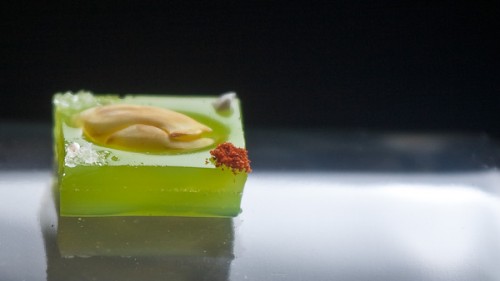
Last week, Sarah and I took a trip out to San Francisco to scout out some areas we might want to live in and see if we could find an apartment. The prices of real estate there were sobering enough to give us a bit of tension for this, but a nice side effect was getting to explore the various neighborhoods we were considering. I mostly kept making beelines for the grocery stores.
I’ve been eyeballing this recipe since last year; it seems simple and pretty. At first I assumed a ‘green almond’ was an easily-substitutable species of almond, but some google searching set me straight. “Green almonds” refer to the state of maturity of an almond; for only a short time of the year (mid-April to mid-June), almonds can be harvested before they have fully hardened into the nut with which most of us are familiar. During this short phase, the almond exists inside of a green furry outer husk, which can be trimmed off to reveal the fruit of the almond inside. There’s an outer shell-like casing around the fruit that has a tiny bit of crunch (like a very thick grape skin, sort of), and the inside of the fruit is gelatinous, like the inside of a grape.
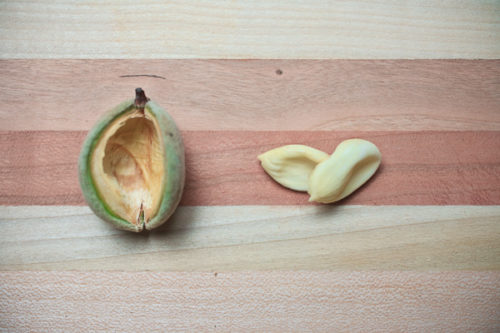
(the above green almond, interestingly-enough, contained ‘twins’; most green almonds just contain one fruit)
Some internet searching for green almonds in New Zealand was largely fruitless, so I turned to the rest of the world to see how I might go about getting some of these. The only retailer I could find online was in the northern hemisphere, which meant when I was dealing with spring dishes in NZ I’d missed the US spring by half a year. They also told me that the time it would take to send the green almonds to NZ would likely be longer than the shelf life of them once picked, so it seemed I was stranded.
Last week, one of my grocery store raids was the Berkeley Bowl. I’d driven by this place a few times years ago when I lived in Oakland, without ever feeling curious enough about it to go in. Mistake. Sarah and I hopped out and went inside; Sarah was immediately entranced by the absolutely massive produce section (incidentally, I used to go to the oil aisle to calibrate myself to a grocery store’s quality. I’m not sure why. It was Sarah who helped me understand why investigating the produce section was far superior of a move). They had an entire island of beautiful organic strawberries, a huge mound of passionfruit (Sarah’s favorite fruit in NZ; she was so sad when we left because she was convinced she’d never be able to find it in the US), and, tucked into a sizable bin next to some exotic fruits, green almonds.
I kinda like that it’s hard for me to go off the clock on this project. I didn’t even hesitate to grab a fistful and buy them. They’re so incredibly rare that I didn’t know how many other chances I’d have to find them. They stayed tucked in my bag for the rest of my time in SF, and then immediately to Chicago with me this past weekend, before arriving back home yesterday for me to jump on this dish with them.
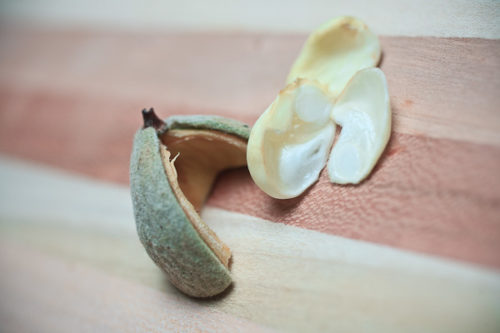
Actual execution of this dish is pretty straightforward; it’s really all about getting the right ingredients and having the right equipment (neither of which, it turns out, I did). Cooking something from this book in Leitchfield, Kentucky is almost as challenging as doing it from New Zealand, for one big reason: we only have one ‘grocery store’.

At least in Wellington we had many large, generously-stocked markets for me to shop at and learn from. This recipe called for gelatin sheets, citric acid, and sugar cubes, none of which I could find there. I wasn’t holding out a ton of hope for the gelatin sheets (I used powdered gelatine instead), but I thought citric acid might be doable (it’s in the baking section of any grocery store in Wellington), and sugar cubes seem like a given.
Also, the recipe calls for juicing some cucumbers. I don’t own a juicer yet.
So. I had to get my MacGruber on for some of this, I decided.
The juiced cucumbers was a pretty easy problem to solve. I recently ordered some microplanes and a chinois, both of which had arrived while I was in SF. I love microplanes, but my new chinois, which replaced some crappy broken small-mesh strainers I had in NZ, is my new favorite thing in the world.
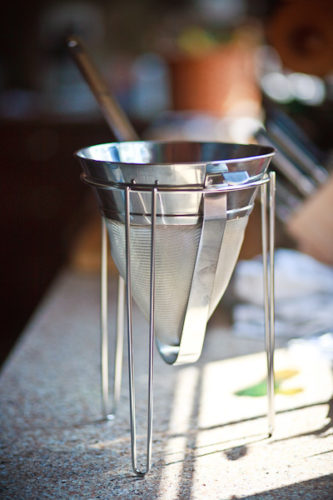
I just microplaned the cucumbers into the chinois, then pushed on the slop a bit with a ladle, and crystal-clear cucumber juice came right out the other side. Easy as.
From the juice, I needed to make a gelee using some gelatin sheets. I’d never seen gelatin sheets before starting this book, and they’re used fairly often. I also hadn’t questioned the preference of sheets to powder until now. From what I can find on the intertubez, sheets are preferred by pro chefs because they can be counted, as opposed to needing to weigh powder. There also seems to be a grade difference in sheets, though the book never specifies this anywhere, and it’s not clear to me what the grade differences represent. Also, I noticed once in NZ that sheets can come in different thicknesses, but again the book never specifies anything about this, so I feel like I’m shooting in the dark a little on my gelatin adventure here. There seems to be some contention as to how much powder equals how many sheets, but I found one resource that said 6 sheets = 1 10g sachet.
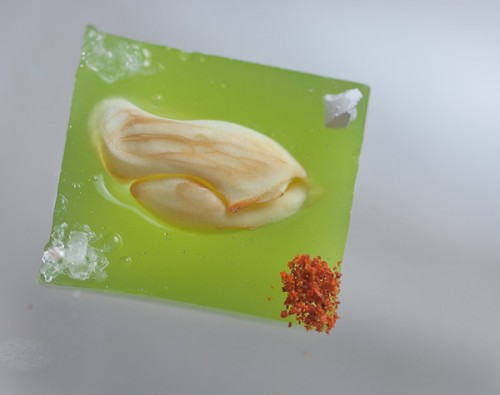
This would have been a helpful conversion if I had read it properly. I did not. What I read (and did) was 1 sheet = 1 10g sachet, so I mixed my juice with 50g gelatine powder, which turned it into this incredible snot that my 7-year-old buddy Oberon would love. I immediately knew I’d screwed it up. I hate jello anyway, so this didn’t bode well for me.
What I’m not sure of (and what I want to experiment with) is the ‘firmness curve’ that results from addition of more and more gelatine. Because I dislike jello, I’m not a connoisseur of the texture of it. We had a variant of this dish at our most recent Alinea dinner, and the gelee bit seemed to melt in my mouth. My own cucumber gelee was definitely ‘chewy’, and ripped into chunks as I ate it, so I need to try this again with the right amount of gelatin to try to get control of the textures it can produce.
Sugar cubes were easy enough to just substitute white sugar for, but the citric acid was a hard one. I went to two pharmacies, as well as the hobby and cleaning sections of Wal-Mart (hobby section: citric acid is combined with baking soda to make bath fizzies. Cleaning section: citric acid is what’s used as a ‘rinse aid’ in dishwashers to soften hard water stains, but it’s often mixed with other chemicals so isn’t food-grade). Strike-outs everywhere. So I tried to think up a substitute. What I landed on was asorbic acid…Vitamin C pills. The chewable ones are cut with corn starch and other stuff to keep them from being harsh in the mouth, but I wanted the purest form of it I could find. I crushed up some tablets of them and used this as my ‘sour’ flavor, but it was definitely a poor substitution. Citric acid is incredibly punchy, and commands attention immediately on the tongue. Vitamin C takes much more ‘tasting it’ before you notice it’s there; neither of my parents could taste it at all when I served them this (which was last night. I saved two servings overnight in the fridge to be able to shoot them today. I noticed, sadly, that the almonds had oxidized a bit in the fridge, giving them some brown spots kind of like what you get after biting into an apple. Fresh out of the husk, they are very pearly in color).
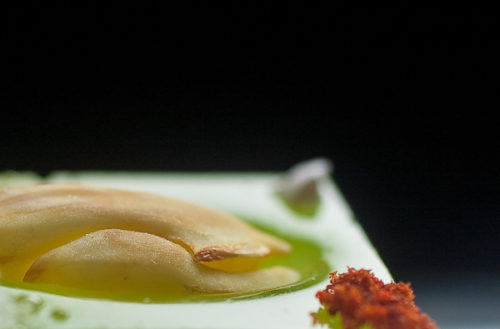
The final product was, just as the variant we had this past weekend, not my favorite. I really, really liked the green almonds themselves. They have a distinct flavor and a very lovely surprising texture. The four corners of flavor were about 2 notches too subtle for me when mixed into the cucumber gelee as I ate it. The sweet and sour were lost entirely. The subtle texture of the almond was drowned in the too-similar texture of the gelee surrounding it. I had to fight through the gelee to get to the almond, whose texture I only really recognized and appreciated because I’d tried one raw when I bought them. Like the sea urchin dish from a while back, I’m left still disliking jello and feeling like it texturally overpowers the very-delicate contents it usually surrounds in this book. I think I need to try playing with it more before writing it off completely though. If this dish or the urchin dish has gelee that was more the consistancy of, say, creamy cheescake or custard, rather than something I have to bite through, then I might like it more. And I suspect that’s exactly the intent Chef Achatz might have; I think I’m just doing it wrong.
For the photogs, here’s a wide shot of my lighting setup. My lighting kit is like a bunch of tinkertoys–it’s very modular, and I can break it down and set it up pretty much anywhere. The black backdrop is the tyvek cover of my dad’s jetski that I found in the garage.
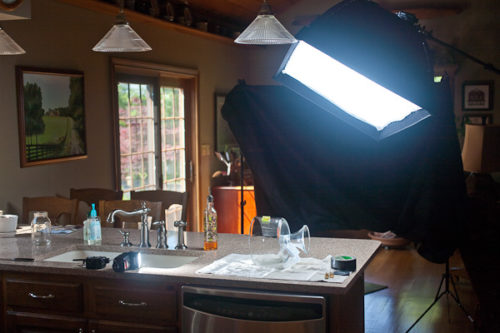
My boom stand is on a boat somewhere in the pacific ocean, which sucks because it’s invaluable for getting a softbox into place over the food. Since I was MacGrubering everything else though, I decided to just make a boom stand with two tripods and some gaffer tape. Worked like a (very delicate, NOBODY TOUCH IT) charm.
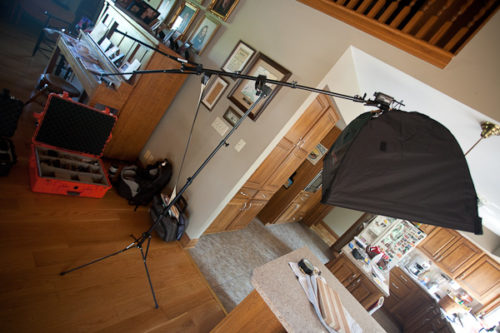
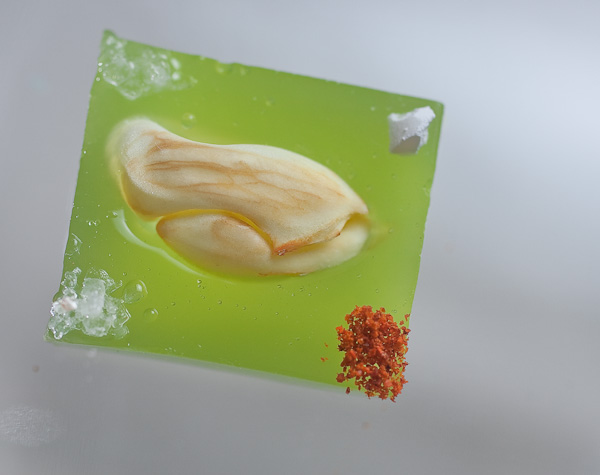
So glad you made it to Berkeley Bowl! It’s my happy place.
Can’t wait to cook with you when you get here!
well done on the Next project, looks so good, love your makings of Alineas work, such a good book, Im a pastry chef living in Auckland(bloody cold now,missing wellington winters?) now for 5 years and now have the chance to go to Alinea for a Stage in October, and hopefully dine there too, Cannot wait, Your blogs awesome and love reading it,